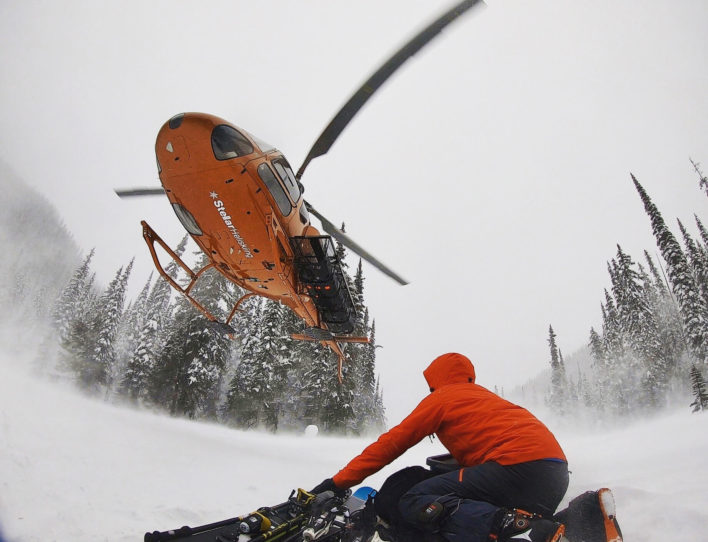On any normal winter day, Informalex, the email list that ski guides across western Canada rely on for beta, is active with discussion about avalanche conditions and route information. In the off-season, the list, only accessible to members of the Association of Canadian Mountain Guides, serves as a forum for bored members to debate guiding-related topics.

I learned about the Infomalex when I texted a guide buddy to ask how concerned ski guides are about climate change. His reply was a lengthy passage scraped from a thread that I now think of as the Hokkaido Letters. These letters started with a simple question: “What creates more carbon emissions? A ski-touring trip to Hokkaido or a domestic heli-skiing trip?”
Guide and helicopter pilot Eric Ridington witnessed the debate online, in which apprentice guide Michael Shynkaryk participated. Says Shynkaryk, “I think that…myself and [another guide] stirred that pot a little bit.”
The truth is that while many of us worry about climate change, only a few take the time to analyze our impact and act on our opportunities. Ridington and Shynkaryk are among the few taking the extra step by developing personal plans to control their emissions, and a two-hour chat with them convinced me that I needed to sit down and calculate my own carbon footprint—and that everyone should. From what I found, the good news is that you don’t have to give up backcountry skiing to make a considerable difference.
Shynkaryk, both a commerce graduate and an engineer in addition to being a guide, conducted a multi-year study of his ski trips and created a model to determine which trips generated the most CO2. The critical number to know about is carbon trace, a simplified metric Shynkaryk created that takes the carbon emissions equivalent in kilograms (CO2e kg) we produce to reach our skiing objectives and divides it by the vertical meters we ski. For example, if we go ski touring and drive 30 miles to the trailhead, Shynkaryk estimates that a good old Toyota Tacoma will generate about 30 kilograms of CO2e in doing so. If we manage to skin up and ski down 2,000 meters that day, we produce a carbon trace of 0.015 CO2e kg/m.
Shynkaryk’s challenge to fellow skiers is to get that value as close to zero as possible. Imagine if we take a vehicle twice as fuel efficient on the same trip. It only produces 15 kilograms of CO2e, and, if we tour the same 2,000 meters, we only produce a trace of 0.0075 CO2e kg/m. Maybe we’re feeling lazy next time and choose to take a heli-bump. In this instance, Shynkaryk calculates the carbon trace by using the CO2e produced by ground and helicopter transportation. Of course, the carbon trace for this type of trip skyrockets.
While Shynkaryk works on his mathematical equations, he offers the following advice for rest of us mere mortals: carpool whenever possible, drive a more fuel-efficient car, ski closer to home and consider more multi-day trips to reduce travel time. Shynkaryk says he’ll drive his Mini Cooper to the trailhead and often stays with friends between guiding assignments to avoid long commutes multiple days in a row.
Eric Ridington has a much more intriguing challenge. As a guide and pilot who flies heli-skiing trips in the winter and supports wildfire suppression in the summer, he’s painfully aware of how his flying job contributes to climate change. To counterbalance his impact, he’s chosen to reduce his day-to-day footprint as much as possible.
It’s an important reminder that, for most people, skiing isn’t the biggest source of their carbon emissions. “Our personal carbon footprint is mostly heating, transportation, [and] food,” Ridington says. He lives in a region where electricity comes from hydroelectric sources, so he heats his house with electricity despite the extra expense. He often chooses to eat local and consume less meat, and, like Shynkaryk, he drives a smaller, economical car.
“Do the obvious and calculate your personal and family carbon footprint [using a tool like] CarbonFootprint.com or CarbonZero.ca,” Ridington recommends. By controlling your day-to-day emissions, he offers, you’ll feel better about the modest amounts you generate on a local ski trip.
While Shynkaryk gradually works toward his goal of zero-emission skiing, Ridington is planning a more dramatic career transition. He’s acquired a Diamond HK36 motor glider and will start offering mountain tours from his base in Nelson, BC. He predicts he’ll only consume seven liters of fuel for an hour’s trip, a fraction of an average helicopter’s burn rate.
At the end of the day, it really is about some number crunching. It turns out, Michael Shynkaryk eventually determined that staying home to participate in seven days of heli-skiing actually produces 1,500 kilograms fewer CO2e than when taking a commercial flight to Hokkaido for human-powered touring.
Learn more about Michael Shynkaryk’s ski-based carbon footprint equations here.










Very important conversation to have in our outdoor community. And very cool that Michael has come up with his carbon trace method of measurement. Nice to see Eric analyzing his own footprint within his industry too!
One point we should add to any of our carbon based measurements is also the flight or flights it may take to get to the ski destination in the first place. ie: skiers flying from Europe to Canada before they even start their trip whether that be heli-skiing or resort skiing. . Skiers flying from N.A., Europe etc to Japan before even starting their skiing. That type of carbon footprint always has to be added to the equation. The cruise ship industry suffers from the same problem. People must fly to the starting point of the crusie and fly home after-wards. All big additions to the carbon “tracing” of one’s activities.